While similar in use, double-edge safety razors and cartridge razors are different shaving tools.
Safety razors are best for facial hair use only. Furthermore, safety razors provide significant cost savings over the long term and reduce razor bumps. However, they are tough to learn, aren’t travel-friendly, and often cause nicks or cuts.
On the other hand, cartridge razors are incredibly safe, versatile, and easy to learn. However, their long-term costs are high, they aren’t eco-friendly, and the multiple blades can lead to ingrown hair or razor burn.
We’ll outline all differences and similarities so you can understand how both of these shaving tools work.
Comparison Table
Here’s a table that outlines all the differences between safety razors and cartridge razors:
| Feature | Safety Razors | Cartridge Razors |
|---|---|---|
| Learning Curve | Requires practice on cutting angle. Mastery in about 10 shaves. | Fixed blades at optimal cutting angle allow for good performance in 1-2 shaves. |
| Razor Bumps | Nearly impossible to get due to single cutting edge. | Curly and coarse hair is susceptible on razors with more blades. |
| Razor Burn | Varies, may depend on other factors. | Varies, may depend on other factors. |
| Upfront Costs | Handle is significantly more expensive | Cheap, usually under $10 |
| Long-Term Costs (+1 year) | Razor blade costs are significantly cheaper | Expensive |
| Environmental Impact | Contains sustainable materials and recyclable | Not environmentally-friendly. Materials take many years to decompose |
| Number of Blades | 1 on either side of head for most models | Between 2-5 |
| Availability of Replacement Blades | Limited | Found in most markets |
| Blade Material | Stainless steel | Stainless steel |
| Pivoting Head | Most models have a fixed head | Most models have a pivoting head |
| Tilting Head | No | Some models tilt side-to-side |
| Travel Friendly | Handle is travel-friendly, blades must be in checked luggage. | Yes |
| Versatility | Intended for facial hair use only. Light chest, legs, and arms are possible. | Can shave hair anywhere on body relatively safe. |
| Weight | Fairly heavy – often more than 100g (3.5oz). | Fairly lightweight. Often under 50g (1.76oz). |
Definition
Before highlighting the differences between these two razors, let’s clarify what each of them is.
- Safety Razor: Introduced in the early 1900s, this razor system relies on a single blade that is held in place by a metal frame. The term safety is due to the safety bar that extends on either side of the blade, preventing the shaver from accidentally cutting themselves while shaving. This razor was an improvement over the straight razor, which required a sharpening stone to maintain the blade’s edge.
- Cartridge Razor: This is a form of safety razor that uses a replaceable multi-blade cartridge. The cartridge is snapped into the handle and can be replaced with a new one when the blades become dull. The first cartridge razor was introduced in 1971 by Gillette with the Trac II.
Design Differences
While primarily designed for shaving facial hair, here are how safety and cartridge razors differ in both form and design:
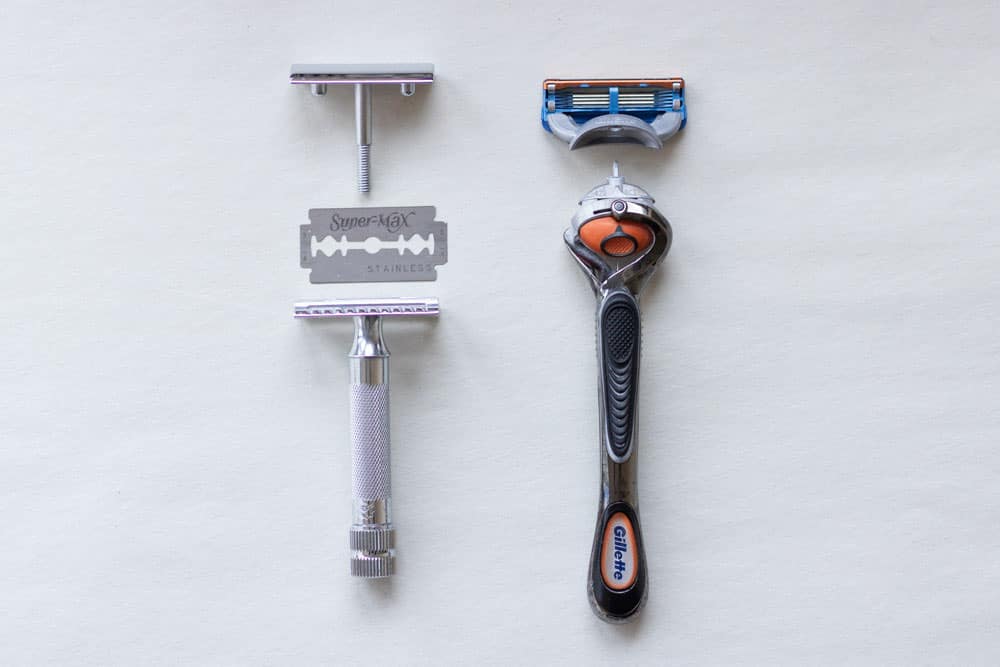
Blades
The biggest difference between these two systems will be the razor blade (long-term cost will be covered later on).
Safety Razor Blades
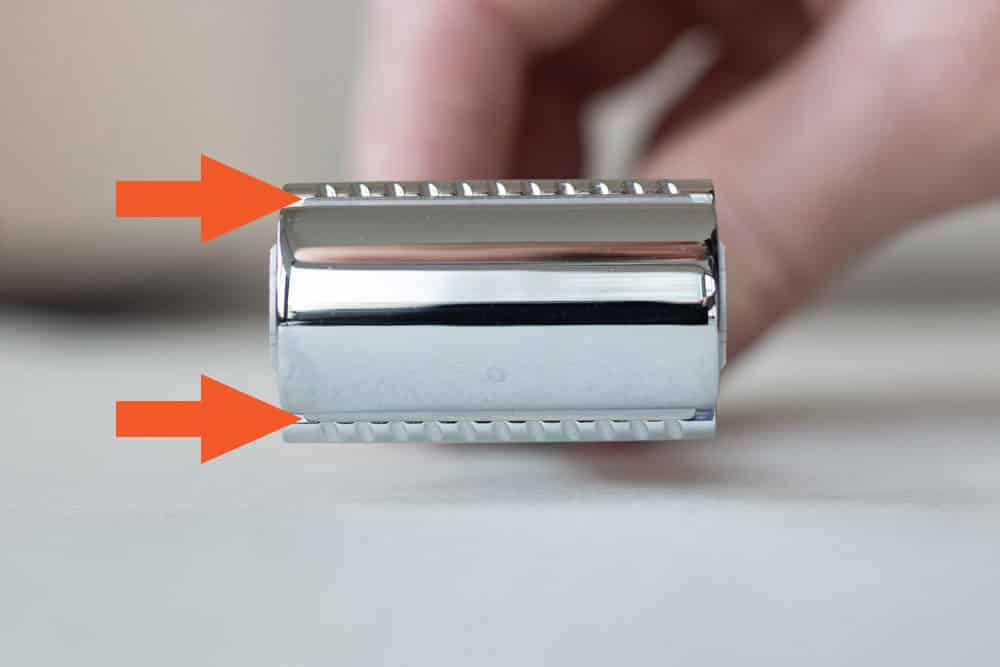
Fast facts:
- Number of blades: 1 (on either side of the head)
- Compatibility: Universal
- Cost: $0.10 to $0.20 per blade
- Contains lubricating strip: No
- Material: Stainless steel
This shaving tool relies on a single cutting blade on either side of the razor head. By relying on a single blade, there is reduced contact with your skin and a shallower cut on your facial hair. Safety razors and their blades have a universal fitting, so you can use different brands without any issues.
Cartridge Razor Blades
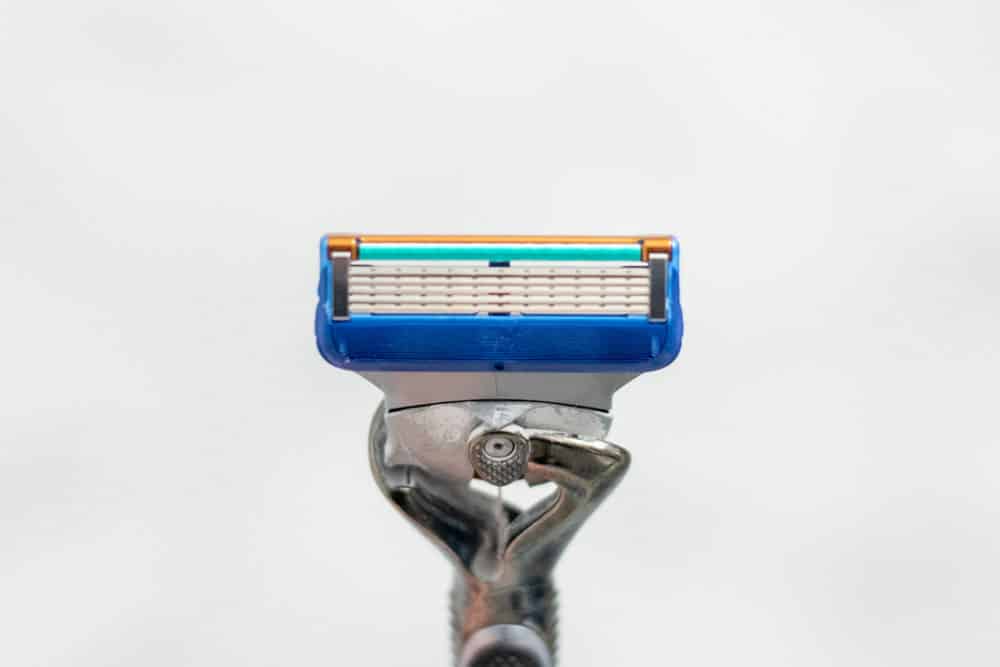
Fast facts:
- Number of blades: 3-5
- Compatibility: Proprietary
- Cost: $2.50 to $4.25 per cartridge
- Contains lubricating strip: Yes
- Material: Stainless steel
Multiple blades on this razor type will lift and cut (hysteresis) hair with every pass. Per Gillette, the increased number of blades also helps to decrease the bulging of the skin under the razor, which ultimately results in a closer, more comfortable shave (source). However, a closer shave may cause irritation or razor bumps in some men. The interchangeable cartridges often have a proprietary fitting, so you can’t use blades from other brands. Lastly, the lubricating strip affixed to the blade reduces friction and irritation.
Pivot Head
A pivoting head on any razor allows it to stay in contact with your skin while shaving. This reduces the chances of cuts, nicks, or irritation. Broadly speaking, cartridge razors have a pivoting head, with some models featuring a side-to-side pivot. In contrast, most safety razors have a fixed head, requiring the person shaving to hold the blade at the optimal 30-degree cutting angle to the skin. However, some modern safety razors, such as the OneBlade core, feature a pivoting head.
Length
Safety razors and cartridge razors will vary in length. However, when compared to one another, a cartridge razor is typically around 5.5″ in length, whereas a safety razor will be around 3.5″. For a better understanding of just how significant this is, here’s how they look side-by-side:
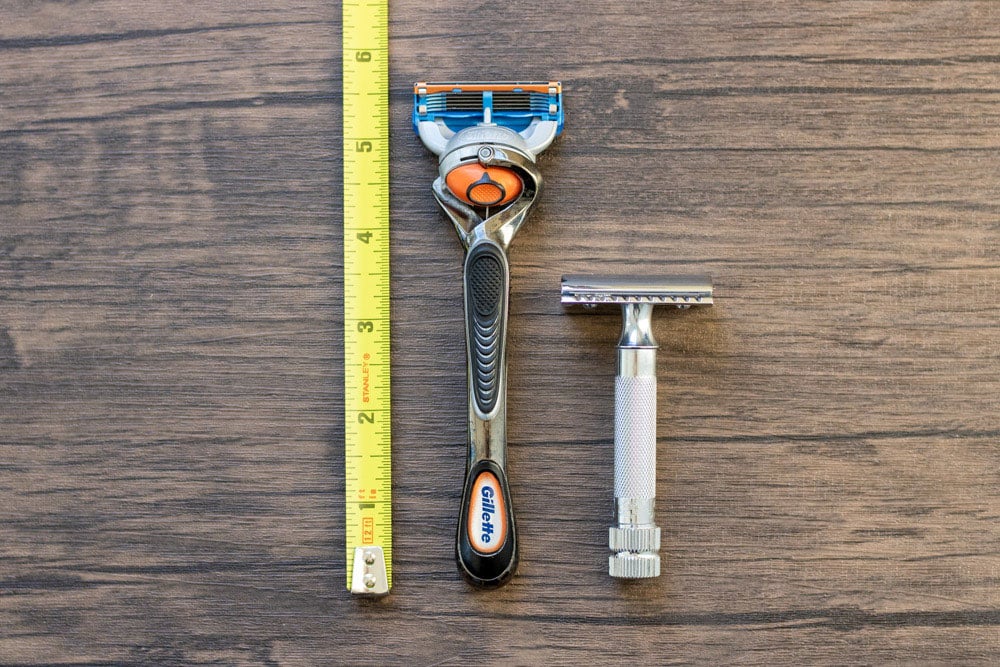
The smaller frame of the safety razor makes it easier to make precise strokes while shaving. The longer handle of the cartridge razor makes it easier to reach and provides a more comfortable grip.
Weight
The weight of the razor depends largely on the composition of the materials used. Many safety razors are made from solid brass or zinc and have chrome-plated bodies, whereas cartridge razors are largely made out of a combination of plastic, rubber, and metal. When shaving with a safety razor, you allow the weight of the razor to do the work for you, meaning little to no extra pressure is required to slice through your facial hair. The lighter frame of cartridge razors requires light to moderate pressure while shaving; too much pressure can lead to irritation or razor burn.
Handle & Grip
Grips on both the safety and cartridge razor vary significantly. Most safety razors have a knurled metal handle, whereas cartridge razors have a rubber grip. Should your hands be wet or coated with shaving cream, the rubber grip on the cartridge razor performs better. However, the reliance on plastic and rubber isn’t the most eco-friendly option; we’ll cover this in more detail later on.
Learning Curve
When learning to shave for the first time, the cartridge razor is undoubtedly easier. The reason is that the blades on cartridge razors have been pre-set to the optimal cutting angle and have a pivoting head, so you never have to worry too much about how the razor is held.
Learning to use a safety razor takes effort. Expect to get acceptable results (no irritation or cuts) after approximately ten consecutive shaves. The primary reason so many men have difficulty with this razor system is the weight and the lack of a pivoting head. You must continuously adjust your hand and arm, so the blade remains at the optimal 30 to 45-degree cutting angle without applying too much pressure.
Long-term cost of ownership
The cost of ownership between these two systems is complicated. Here’s why:
Razor blade refills
Here’s what you can expect to pay in razor blade refills when using each of these shaving systems for one year:
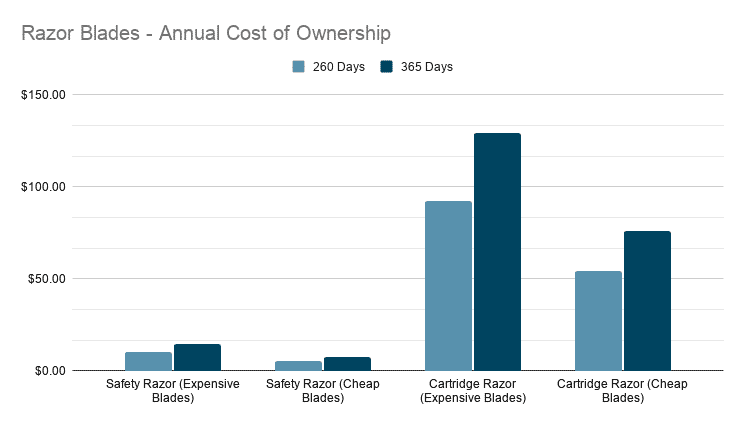
| # Of Shaves | Safety Razor (Expensive Blades) | Safety Razor (Cheap Blades) | Cartridge Razor (Expensive Blades) | Cartridge Razor (Cheap Blades) |
|---|---|---|---|---|
| 260 Days | $10.40 | $5.20 | $92.08 | $54.17 |
| 365 Days | $14.60 | $7.30 | $129.27 | $76.04 |
Definitions:
- 260 Days: This is roughly how many business days there are in each year (52 weeks x 5 days = 260 days). This excludes holidays, vacations, and sick days.
- 365 Days: Expectations that you shave every day of the year.
- Safety Razor (Expensive Blades): Feather razor blade at $0.20 per blade.
- Safety Razor (Cheap Blades): Derby razor blade at $0.10 per blade.
- Cartridge Razor (Expensive Blades): Gillette Proshield at $4.25 per blade.
- Cartridge Razor (Cheap Blades): Schick Hydro 5 at $2.50 per blade.
Furthermore, we assumed that a safety razor blade would last about five shaves before replacement, whereas a cartridge razor blade would last about 12 shaves before replacement.*
As you can see from the data above, the cost of ownership between each razor system is high. If you shave every day for work, you can expect to pay anywhere between $54 and $130 per year for cartridge razor blades alone. For safety razor blades, you would only need to pay about $5 to $15 per year.
* Unfortunately, companies rarely state how many shaves a razor blade will be good for. This is our best estimate based on personal experience and interpretation of various razor brands’ FAQs.
Initial costs
The cost of the razor handle varies between brands, especially for safety razors. Here we wanted to present the data that we found for popular safety and cartridge razors:
| Type | Razor | Price |
|---|---|---|
| Safety Razor | Merkur 34C | $40.00 |
| Safety Razor | Merkur 38C | $60.00 |
| Safety Razor | Edwin Jagger DE89 | $31.00 |
| Safety Razor | Muhle R89 | $44.00 |
| Cartridge Razor | Gillette Mach 3 | $7.00 |
| Cartridge Razor | Gillette Proshield | $10.00 |
| Cartridge Razor | Schick Hydro | $10.00 |
| Cartridge Razor | BIC Flex 4 | $5.00 |
The average cost for a safety razor was $43.75, whereas the cartridge razor, on average, costs about $8.00. That is an average difference of $35.75. Lifespan is difficult to determine for both razor types. There is an argument to be made that both can last for several years. Ultimately, a safety razor, given the heavy-duty materials that it is made from, is expected to have a longer lifespan.
Total Cost
When comparing safety and cartridge razors, the difference isn’t nearly as great as is often assumed. Here are a few different comparisons to demonstrate why:
| Razor System | Handle Cost | Blades (365 Days) | Total = Handle + Blades (365) | Blades (260 Days) | Total = Handle + Blades (260) |
|---|---|---|---|---|---|
| Gillette Proshield | $10.00 | $129.27 | $139.27 | $92.08 | $102.08 |
| Schick Hydro | $10.00 | $76.04 | $86.04 | $54.17 | $64.17 |
| Merkur 38C + Expensive Blades | $60.00 | $14.60 | $74.60 | $10.40 | $70.40 |
| Edwin Jagger DE89 + Cheap Blades | $44.00 | $7.30 | $51.30 | $5.20 | $49.20 |
As you can see in the data above, if you get a Gillette Proshield and shave 365 days a year (unrealistic for most), you can expect to spend about $139 for the first year. For the same shave routine but with a cheap safety razor, the total cost comes to $51. This is a net difference of $88.
While the savings are significant, you would need to commit to this razor and the cheaper blades for several years before real savings begin to build up.
But take this scenario:
When comparing the Schick Hydro ($64) to the Merkur 38C with Feather razor blades ($70), the Schick Hydro actually ends up saving you $6. Of course, the safety razor handle is a one-time expense that goes away after the first year. Ultimately, if you are committed to the long haul and want to save money, then the safety razor is cheaper.
Hidden Costs
While we went over how much each of these razor systems costs in a perfect environment, there are a few hidden costs that you should be aware of:
- Travel: Post 9/11, the razor blades used by safety razors are prohibited in carry-on luggage (source). However, the safety razor handle without the blade is okay to travel with. Therefore, you will either need to bring a disposable razor with you or you will need to pay a checked luggage fee if you really want to travel with your safety razor and blades.
- Environmental Impact: One of the leading reasons both men and women have started to consider safety razors is due to their environmentally-friendly design. Safety razors can be recycled, are made from sustainable materials, and require less frequent replacement making them much better for the environment. Cartridge razors contain plastic and rubber, which may take several hundred years to decompose in a landfill (source). Recycling a cartridge razor must be done through special collection programs as we covered here.
- Versatility: One of the advantages that the cartridge razor enjoys is its ability to shave everything. Whether you are shaving your facial hair, head, chest, groin, etc., the cartridge razor can provide good results with little chance of you cutting yourself. While some can use a safety razor for such purposes, it is not advised unless the surface that you are shaving is extremely flat (i.e., legs or chest).
Do you favor a traditional or modern shave?
Some folks prefer a traditional barbershop-style shave with the safety razor, while others look for modern and efficient results with the cartridge razor. This is a personal preference and, as a result, dictates which razor system you should use.
How hair length impacts the shave
When shaving longer hair, about a week’s worth of growth, a cartridge razor can easily clog. This can increase the number of passes required and simply make for a frustrating shaving experience. Many safety razors have an advantage here as they only rely on a single blade. While still susceptible to mild clogging, it is less likely. You may want to consider this razor type if you shave infrequently.
Does one type of razor work better for razor bumps?
Razor bumps are a result of the hair being shaved too aggressively and then growing back into the skin. Due to the lift-and-cut action of the cartridge razor, this is a common problem, especially for men with exceptionally curly or coarse hair. To avoid razor bumps, the single cutting edge of a safety razor works better.
However, cartridge razor brands like Gillette have recently introduced a new line of razors, the Gillette SkinGuard, that are designed to reduce the likelihood of razor bumps as the blades are spaced further apart. It may be worth checking out that particular razor if you still want the modern offerings of a cartridge razor.
What about razor burn?
Razor burn is a tricky problem that may be the symptom of many different things, including shaving technique, shaving cream, sharpness of the blade, and skin sensitivity. Safety or cartridge razors don’t really have an advantage here.
How do disposable razors factor into the equation?
Disposable razors are intended for one-time use only and feature many of the same design characteristics as cartridge razors. While cheap and convenient, they are extremely wasteful and are not recommended for long-term use. In fact, some support is starting to grow to ban the sales of disposable razors due to their environmental impact (source).